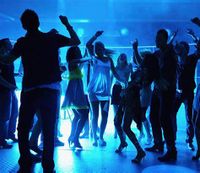Discothèque
A discothèque, (IPA: [diskoˈtɛk̚]) is an entertainment venue or club with recorded music played by "Discaires" (Disc jockeys) through a PA system, rather than an on-stage band. The word derives from the French word discothèque (a type of nightclub). Discothèque is a portmanteau coined around 1941 from disc and bibliothèque (library) by La Discothèque, then located on the Rue de la Huchette in Paris, France. Previously, most bars and nightclubs used live bands as entertainment.
1960s and early 1970s
By the late 1960s, American versions of the discotheque started to catch on, and with these clubs, the demand for new dance steps such as the Frug, the Merengue, and the Mule skyrocketed.
Record labels feverishly rushed out whole albums of music to monkey or limbo by, or else mimicked the discotheque effect by assembling compilations of everything from the foxtrot to the boogaloo. Dance instructors got in on the act, releasing LPs such as "Killer Joe's International Discotheque."
1970s and early 1980s
By the late 1970s, many major US cities had thriving disco club scenes which were centered around discotheques, nightclubs, and private loft parties where DJs would play disco hits through powerful PA systems for the dancers. The DJs played "... a smooth mix of long single records to keep people “dancing all night long" "Some of the prestigious clubs had elaborate light organs, which converted audio signals into colored lights that throbbed to the beat of the music or even glass-floored dance floors with colored lights.
Some cities had disco dance instructors or dance schools that taught people how to do popular disco dances such as "touch dancing", the "hustle" and the "cha cha." There were also disco fashions that discotheque-goers wore for nights out at their local disco, such as sheer, flowing Halston dresses for women and shiny polyester Qiana shirts for men with pointy collars, preferably open at the chest, often worn with double-knit suit jackets.
In addition to the dance and fashion aspects of the disco club scene, there was also a thriving drug subculture, particularly for drugs that would enhance the experience of dancing to the loud music and the flashing lights, such as cocaine (nicknamed "blow"), amyl nitrite "poppers", and the "...other quintessential 1970s club drug Quaalude, which suspended motor coordination and turned one’s arms and legs to Jell-O." The "[m]assive quantities of drugs ingested in discotheques by newly liberated gay men produced the next cultural phenomenon of the disco era: rampant promiscuity and public sex. While the dance floor was the central arena of seduction, actual sex usually took place in the nether regions of the disco: bathroom stalls, exit stairwells, and so on. In other cases, the disco became a kind of “main course" in a hedonist’s menu for a night out."
Famous 1970s discotheques included "...cocaine-filled celeb hangouts such as Manhattan's Studio 54 ", which was operated by Steve Rubell and Ian Schrager. Studio 54 was notorious for the hedonism that went on within; the balconies were known for sexual encounters, and drug use was rampant. Its dance floor was decorated with an image of the "Man in the Moon" that included an animated cocaine spoon. Other famous discotheques included the Loft, the Paradise Garage, and Aux Puces, one of the first gay disco bars.
2000s
Today the term discothèque is usually synonymous with nightclubs in France because disco music is still very popular there, but in contemporary English usage, it is now very dated, because nightclubs have not been commonly called "discos" since the early 1980s. The term "disco" was originally a 1960s US abbreviation of discothèque, a place where "disco music" was played.
Chat rooms • What links here • Copyright info • Contact information • Category:Root
